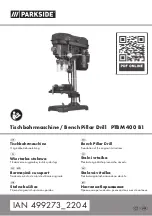
Page 7
Fig. 5
Fig. 4
OPERATION
VARIABLE SPEED
CONTROL SELECTOR
TO INCREASE SPEED
TO DECREASE SPEED
REVERSIBLE
See Figure 4.
Your drill has the feature of being reversible. The direction of
chuck rotation is controlled by a lever located above the
switch trigger. With your drill held in normal operating posi-
tion, the direction of rotation lever should be positioned to the
left of the switch for drilling operation. The direction of
rotation is reversed when the lever is to the right of the switch.
The design of the switch will not permit changing the
direction of rotation while the drill is running. Release
the switch trigger and allow the drill to stop before
changing its direction.
NOTE: Your drill will not run unless switch lever is
pushed fully to the left or right.
VARIABLE SPEED
See Figure 5.
Your drill has a variable speed control selector designed to
allow operator control and adjustment of speed and torque
limits. The speed and torque of your drill can be increased or
decreased by rotating the variable speed control selector in
the direction of the arrows shown in figure 5.
NOTE: Hold your drill in normal operating position and turn
the variable speed control selector clockwise to increase the
speed and torque of your drill. Turn counterclockwise to
decrease the speed and torque of your drill.
If you desire to lock the switch on at a given speed, depress
the switch trigger, push in and hold the lock-on button, and
release the switch trigger. Next, adjust the variable speed
control selector until the desired speed is reached.
NOTE: If the variable speed control selector is fully
turned in the counterclockwise direction (zero setting)
your drill may not run.
If you desire not to use the variable speed control
selector, turn it in the full clockwise direction. This will
allow the speed of your drill to be fully controlled by the
amount of switch trigger depression.
Avoid running your drill at low speeds for extended periods of
time. Running at low speeds under constant usage may
cause your drill to become overheated. If this occurs, cool
your drill by running it without a load and at full speed.
The following guidelines may be used in determining correct
speed for various applications:
LOW speed is ideal when minimum speed and power is
required. For example: starting holes without center punch-
ing, driving screws, mixing paint, and drilling in ceramics.
MEDIUM speed is suitable for drilling hard metals, plastics,
and laminates.
HIGH speed produces best results when maximum power is
required. For example: drilling in wood; soft metals such as
aluminum, brass, and copper; and when using driving acces-
sories.
FORWARD-REVERSE
LEVER
REVERSE
FORWARD






























